
Wells
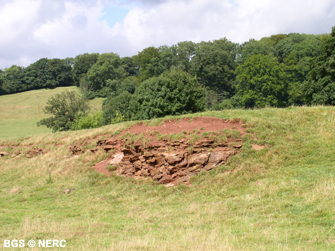
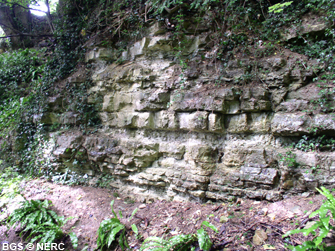
The city of Wells is dominated by its superb cathedral and the springs which rise around its walls. However, the area is also interesting for its geology. The city is overlooked by the sandstone massif of Pen Hill and flanked by ridges of Carboniferous Limestone which are partially buried by younger Triassic strata and gravel deposits upon which most of the city is built.
The Carboniferous Clifton Down Limestone is well exposed in many small pits and quarries on Tor Hill to the west of the city. This ridge forms the axis of an upfold or anticline which can be seen in the adjacent concrete block-works. The ridge is flanked on either side by Triassic rocks. The Clifton Down Limestone is also exposed in several quarries around Stoberry Park north of the city and in the entrance to Stoberry Park tunnel. One of the old quarries is now a private garden.
The unconformity between the limestone and the overlying Dolomitic Conglomerate can be seen in a field just west of the A39 near Stoberry. The conglomerate can also be seen in Milton Lane and in the lower parts of Biddlecombe.
The topmost Triassic and basal Jurassic rocks outcrop around Milton, north of Wells and can be seen in the New Cut, Milton.
Wells Cathedral
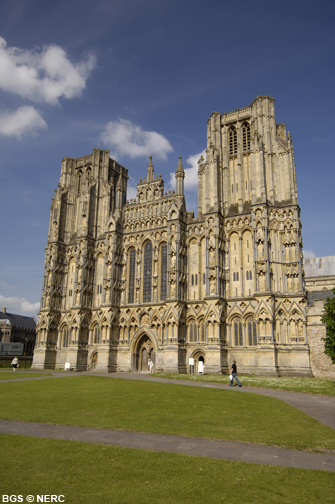
The cathedral was started in the 12th century using mostly local stone and is an excellent place to examine the local geology. Much of the cathedral, including the nave and the west front is built from the Inferior Oolite. Also known as 'Doulting Stone' this beautiful yellow rock was obtained from quarries around Doulting, near Shepton Mallet. Later in the 12th century, local 'Chilcote Stone', a local variation of the Lower Jurassic Downside Stone, was used as a replacement when the Doulting quarries were under the control of Glastonbury Abbey and unavailable. It was obtained from small quarries between West Horrington and Shepton Mallet and can be seen in walls around Horrington.
The west wall of the west cloister is formed of rubble blocks of the Triassic Dolomitic Conglomerate. The Jurassic Blue Lias has been used extensively for paving slabs and tombstones. This greyish blue rock can be split easily and is often used for flagstones, but suffers from frost heaving. Dark reddish brown Carboniferous Coal Measure 'Pennant' Sandstone slabs have also been used for paving and in some of the gravestones.
The grey columns on the West Front are of 'Kilkenny Marble', actually a fine-grained Carboniferous limestone shipped in from Ireland in 1872. This rock was chosen because it could be easily worked to produce the columns. If the surface is wetted crinoid fragments and algal patches can be seen. Inside the cathedral, the Jurassic Great Oolite Limestone, a golden-yellow oolitic limestone better known as Bath Stone, was used for fine carved work such as the font and the pulpit. However, the vaults were made from tufa, a very light rock formed of calcium carbonate deposited by lime-rich springs and streams, principally because of its lightweight porous nature.
Wells and springs
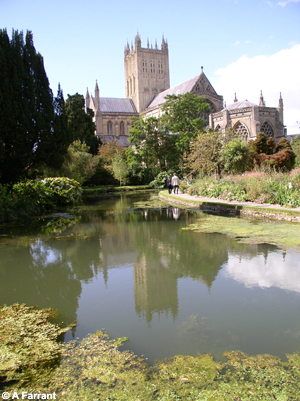
Wells, as its name suggests, grew up around a series of springs known as St Andrews Risings. These rise up in the floor of an ornamental lake in the grounds of the Bishops Palace. One of these, the Scotland Spring supplies the water that feeds the conduit in the Market Place, from where water flows down the High Street in stone gutters made from the Jurassic Blue Lias Formation. Dye tracing proves that all these springs are fed by a single underground conduit in the underlying Carboniferous Limestone, which bursts up through the overlying Triassic strata. These springs are fed by stream sinks on the slopes of Beacon Hill to the north-east of Wells.
Wells and Mendip Museum
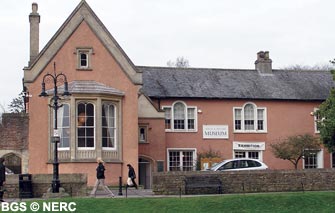
Adjacent to the cathedral on Cathedral Green is the Wells and Mendip Museum Founded in 1893, it houses a fine collection of local rocks, fossils and minerals, as well as displays about the history of cave diving. It is a good starting point to learn about the geology of the region. The museums founder, Herbert Balch (1869–1958) was a pioneering caver and amateur archaeologist who held a lifelong interest in the geomorphology and history of Mendip.
Quarrying
South-east of Wells is Dulcote Quarry, a working aggregate quarry formerly run by Foster Yeoman Ltd. The Clifton Down Limestone here is folded so much it is now vertical or even overturned; spectacular testament to the enormous geological forces operating at the end of the Carboniferous.
Overlying the Carboniferous Limestone are beds of the Triassic Mercia Mudstone and Dolomitic Conglomerate which contained concretionary nodules and geodes infilled with quartz crystals known locally as 'potato stones' or 'Bristol diamonds'.
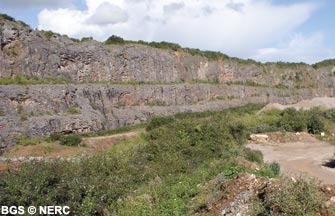
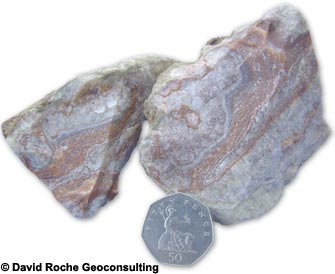
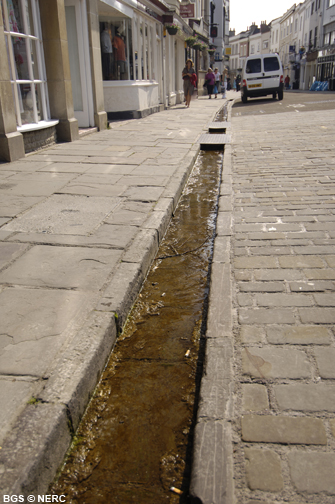
- Home
- Overview maps
- Locality
areas
- Cheddar Gorge
- Charterhouse
- Blackdown
- Burrington Combe
- Shipham & Rowberrow
- Crook Peak & Axbridge
- Banwell to Churchill
- Priddy
- Harptree & Smitham Hill
- Draycott & Westbury-sub-Mendip
- Wookey Hole & Ebbor Gorge
- Wells
- Great Elm & Vallis Vale
- Mells & the Wadbury Valley
- The Vobster area
- The Whatley area
- Torr Works & Asham Wood
- Beacon Hill
- Stoke St Michael & Oakhill
- Holwell & Nunney
- Shepton Mallet & Maesbury
- Gurney Slade & Emborough
- The Nettlebridge valley
- Geology
- Minerals and mines
- Quarrying
- Caves and karst
- Biodiversity
- Detailed site information
- Acknowledgements
- External links
- Search
- Site map